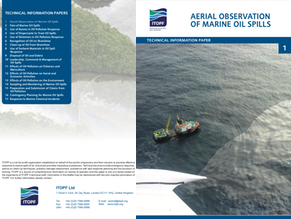Technical Information Papers
ITOPF's series of Technical Information Papers has been updated and expanded to reflect technological advances and ITOPF's more recent collective experience on a wide range of marine pollution topics.
Each paper covers a specific subject in a concise manner, illustrated with photographs and diagrams.
TIPs are available in the following languages:
TIP 01: Aerial observation of marine oil spills
This paper presents advice and guidance on conducting effective aerial reconnaissance.
Categories: Fate of Oil Spills, Response Techniques, Planning & operations, Spill Response, Technical Information Paper (TIPS)
TIP 03: Use of booms in oil pollution response
This paper describes the principles of boom design and the two main modes of operation, namely towing by vessels at sea and mooring in shallow or inshore waters.
Categories: Response Techniques, Containment & Recovery, Planning & operations, Technical Information Paper (TIPS)
TIP 04: Use of dispersants to treat oil spills
This paper provides an overview of the use and limitations of dispersants on floating oil, as one of a range of options available for response to ship-source marine oil spills.
Categories: Response Techniques, Dispersants, Technical Information Paper (TIPS)
TIP 05: Use of skimmers in oil pollution response
This paper describes the fundamental requirements for the successful use of skimmers in the situations most likely to be encountered during an oil spill and should be read in conjunction with other ITOPF papers in this series, in particular, on the use of booms, shoreline clean-up techniques and the disposal of oil.
Categories: Response Techniques, Containment & Recovery, Planning & operations, Technical Information Paper (TIPS)
TIP 06: Recognition of oil on shorelines
In cases of large spills, the source of stranded oil may be obvious, but the question of identification frequently arises when a small amount of oil is involved and compensation is sought for damage or clean-up costs. The purpose of this paper is to assist the reader in recognising both the type and quantity of oil on differing shorelines.
Categories: Response Techniques, Planning & operations, Technical Information Paper (TIPS)
TIP 07: Clean-up of oil from shorelines
This paper describes commonly used shoreline clean-up techniques and provides advice on which are best suited to each stage of operations for a range of different shoreline types.
Categories: Response Techniques, Technical Information Paper (TIPS)
TIP 08: Use of sorbent materials in oil spill response
This paper considers the types of sorbents available and how they may be used beneficially in a response. It should be read in conjunction with other ITOPF papers in this series, particularly on the use of booms, the use of skimmers, shoreline clean-up techniques and the disposal of oil and debris.
Categories: Response Techniques, Technical Information Paper (TIPS)







